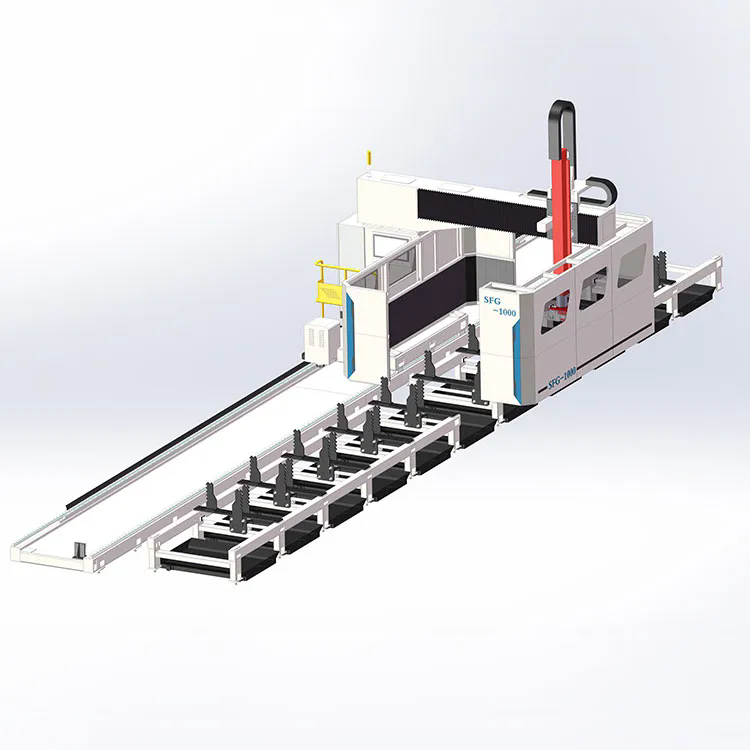Unlocking Precision and Efficiency: The Rise of H Beam Laser Cutting Machines
2024-10-18
In the world of manufacturing and metalworking, precision and efficiency are paramount. Among the various technologies that have revolutionized this field, H beam laser cutting machines stand out for their ability to deliver accurate cuts with minimal waste. These advanced machines are designed to cut H beams and other structural steel components quickly and efficiently, making them an essential tool in various industries, including construction, automotive, and manufacturing. In this blog post, we’ll explore what H beam laser cutting machines are, how they work, their benefits, and their applications in modern manufacturing.
What is an H Beam Laser Cutting Machine?
An H beam laser cutting machine is a specialized equipment used to cut H-shaped steel beams, which are widely used in construction and infrastructure projects. The machine utilizes a high-powered laser to slice through metal with incredible accuracy, making it possible to create intricate designs and precise dimensions.
Key Components of H Beam Laser Cutting Machines:
- Laser Source: Generates a high-intensity beam of light, typically from CO2 or fiber lasers, to cut through materials.
- Cutting Head: Houses the optics that focus the laser beam onto the material, ensuring precision.
- Motion System: Moves the cutting head along multiple axes to achieve complex cuts and patterns.
- Control System: Interfaces with the operator to input designs and manage the cutting process, often featuring advanced software for enhanced efficiency.
How H Beam Laser Cutting Machines Work
The operation of an H beam laser cutting machine involves several key steps:
1. Design Input: The desired cutting pattern is designed using CAD software and then inputted into the machine’s control system.
2. Material Loading: H beams are loaded onto the cutting table, typically equipped with clamps or fixtures to secure the material in place.
3. Laser Cutting Process: The laser is activated, and the cutting head moves along the programmed path, melting or vaporizing the material as it goes. The high temperatures generated by the laser create clean, precise cuts.
4. Cooling and Finishing: After cutting, the machine may incorporate a cooling system to prevent warping of the material. Some machines also feature finishing options to smooth edges or remove slag.
5. Quality Control: The finished pieces are inspected to ensure they meet the required specifications before being moved to the next stage of production or construction.
Benefits of Using H Beam Laser Cutting Machines
1. Precision Cutting
One of the most significant advantages of laser cutting technology is its precision. H beam laser cutting machines can achieve tolerances as tight as ±0.1 mm, ensuring that each piece meets strict dimensional requirements. This level of accuracy reduces the need for additional machining processes, saving time and costs.
2. Versatility
H beam laser cutting machines are incredibly versatile. They can cut various materials, including mild steel, stainless steel, and aluminum, making them suitable for a wide range of applications in different industries. Furthermore, they can handle various thicknesses, allowing for flexibility in production.
3. Reduced Waste
Laser cutting produces less waste compared to traditional cutting methods. The focused beam minimizes kerf (the width of the cut), which means more material is preserved for use in other projects. This efficiency is not only cost-effective but also environmentally friendly.
4. Speed and Efficiency
These machines can operate at high speeds, drastically reducing production time. The combination of rapid cutting and minimal downtime between operations leads to increased overall productivity.
5. Automation and Integration
H beam laser cutting machines can be easily integrated into automated production lines, allowing for seamless workflows. Many modern machines come equipped with software that enables real-time monitoring and adjustments, further enhancing efficiency.
Applications of H Beam Laser Cutting Machines
1. Construction Industry
H beams are fundamental components in construction projects, providing structural support in buildings, bridges, and other infrastructure. Laser cutting machines enable precise fabrication of these beams, ensuring they meet engineering specifications.
2. Automotive Industry
In the automotive sector, laser cutting is used to manufacture parts and components for vehicles. The precision and speed of H beam laser cutting machines make them ideal for producing high-quality automotive structures.
3. Manufacturing
Many manufacturing processes require precision-cut steel components. From machinery to equipment frames, H beam laser cutting machines help create the necessary parts with accuracy and speed.
4. Shipbuilding
The shipbuilding industry benefits from laser cutting technology due to its ability to cut thick materials precisely. H beams are often used in the construction of ship frames, making this technology essential for shipyards.
Conclusion: The Future of Metal Cutting with H Beam Laser Cutting Machines
H beam laser cutting machines represent a significant advancement in metalworking technology. With their unparalleled precision, efficiency, and versatility, they are transforming the way industries approach fabrication and manufacturing.
As industries continue to evolve and the demand for high-quality components rises, the role of H beam laser cutting machines will only grow. Investing in this technology not only enhances production capabilities but also positions manufacturers for success in an increasingly competitive market.
Incorporating H beam laser cutting machines into your operations can lead to improved productivity, reduced waste, and superior product quality. Embrace the future of manufacturing and unlock the potential of laser cutting technology for your business!



